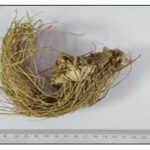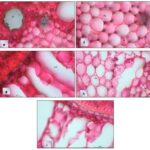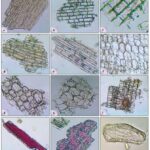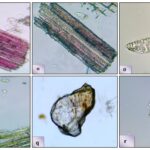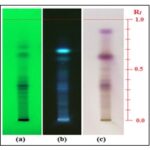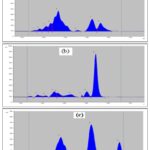PHARMACOGNOSTICAL EVALUATION AND PHYTOCHEMICAL CHARACTERISATION OF VETIVERIA ZIZANIOIDES (L.) NASH ROOTS
HTML Full TextPHARMACOGNOSTICAL EVALUATION AND PHYTOCHEMICAL CHARACTERISATION OF VETIVERIA ZIZANIOIDES (L.) NASH ROOTS
Dutta *, S. Mondal, K. Hazra, A. K. Mangal, R. Bolleddu, J. Dahiya, S. Kharwar and P. V. V. Prasad
Central Ayurveda Research Institute, 4-CN Block, Sector-V, Bidhannagar, Kolkata, West Bengal, India.
ABSTRACT: Vetiveria zizanioides (L.) Nash has been suggested in the Indian system of medicine as the roots of Usira for a number of diseases such as fever, dysuria, fatigue syndrome, wound healing, skin disorders, etc. (Jvara, Trishna, Mutrakrachhra, Vrana). This will be created helpfulness towards this medicinal plant and for preparation of different Ayurvedic formulations i.e Usira sava, Yogarajaguggulu, Sadanga Kvatha Curna. The objective of the present study is to develop the pharmacognostic and phytochemical profiles of Vetiveria zizanioides (L.) Nash root. The present study considers the detail investigation of macroscopy, microscopy, preliminary qualitative phytochemical analysis, physicochemical evaluations and HPTLC chromatography profiling. Microscopical investigation shows the presence of rectangular cells of epidermis, elongated and polygonal parenchyma groups, oval aerenchymatous cells, cork cells, elongated cells sclereids, sclerenchymatous stone cells, groups of sclerenchymatous fiber, prismatic crystals of calcium oxalate and starch grains. The presence of various secondary metabolites was confirmed by phytochemical screening and HPTLC profiling. Identification and authentication of roots may be helpful from botanical and chemical screening data for developing pharmacopoeial standards.
Keywords: Vetiveria zizanioides, Cytomorphology, Microscopy, Phytochemical, Physicochemical, HPTLC fingerprint
INTRODUCTION: Vetiveria zizanioides (L.) Nash syn. Chrysopogon zizanioides (L.) Roberty or Vetiver (Family Poaceae) is a fast-growing perennial grass, commonly known as Virana, Adhaya, Sevya (Sanskrit), Khasa, Bena, Khas (Hindi), Khas-khas, Vennaramula (Bengali), Sugandhivalo, Valo (Gujrati), Bala, Vala (Marathi), Ramacham, Lamajja (Malayalam), Vetiver, Vilamichaver (Tamil), Vetivelu, Vettiveru (Telugu). The plant belongs to the.
The highly valued thick fibrous adventitious roots are aromatic in nature. This tufted grass grows throughout India's plains, ascending up to an elevation of 1200 m. Though it originated in India, Vetiver is widely cultivated in tropical regions. It has been reported that almost all Vetiver grown worldwide are a single clone (same DNA) 1.
It is known to improve a person's breathing, lower their heart rate, and be a relaxant for the nervous system. It has also exhibited anti-inflammatory properties, controls diabetes, and is known to cure skin diseases 2. The plant's root is also known as traditional herb for their cooling and diuretic activity. The root decoction is used as an analgesic, Anthelmintic 3, antipyretic 4, antioxidant 5 and antituberculosis agent 6.
Aqueous extract from whole plant of Vetiveria exhibits antioxidant activity 7 and its root extract exhibits anticancer activity against breast cancer cell lines 8. Several studies show that this plant contains in the plant are khusimol, khusimone, vetivene, khositone, vetiverol, vetivone, terpenes, benzoic acid etc 9, 10. The volatile oil extracted from the root of VZ contains monoterpenes, sesquiterpene and triterpenes 11. Vetiver oil is commonly used as a main odor contributor in the perfume industry and as a flavor agent for food in the food industry 12. This work aims to analyze the pharmacognostical study, including powder microscopy and transverse section. The chemical study includes phytochemical screening, physico-chemical parameters, and HPTLC fingerprint profile
MATERIALS AND METHODS:
Solvents and Chemicals: The chemicals, reagents, solvents of Emplura grade, and Aluminium supported Thin Layer Chromatography plates were purchased from E. Merck Ltd., Mumbai, India.
Plant Materials Collection and Authentication: Matured roots of Vetiveria zizanioides (L.) Nash syn. Chrysopogon zizanioides (L.) Roberty was collected from natural habitat of Baruipur, South 24 pgs, West Bengal (22.3508°N 88.4171°E) on September 2021. Underground root portions (in tuft of bunch) from the peripheral shoot region were separated and authenticated (Voucher specimen no. CARI/Kol/RT-18) by Dr. M. N. Das, ex-scientist, Dept. of Pharmacognosy, Central Ayurveda Research Institute for Drug Development, Kolkata, West Bengal.
Plant Sample Processing: The plant materials i.e., root were washed with aqueous 70% (v/v) ethanol, and dried at an ambient temperature (24-27 °C). A small portion of the air-dried plant sample was used for macroscopic, organoleptic and anatomical (transverse section) studies, while the rest of the plant materials were shade dried and pulverized with a grinder (National SM 2000). The whole and powdered plant samples were stored at room temperature in airtight, light-resistant containers as per guidelines of Ayurvedic Pharmacopoeia of India13. The finely (sieved in 60# mesh) and coarsely powdered samples were used for powder analysis, physicochemical, phytochemical and chromatographical examinations according to the standard method.
Macroscopy of Plant Material: The morphological parameters viz. structure, shape, size, texture of the plant material were noted by naked eye observation with a simple microscope (Olympus OIC DM), and organoleptic parameters viz. colour, odour, taste were noted by sense organs etc 13, 14.
Cytomorphology of Plant Material: The fresh root samples were transversely sectioned with a clean, sharp diamond edge blade. The selected sections were treated with a graded ethanol procedure (starting from 30%, towards absolute grade along with safranin stain), mounted on slides in Canada balsam, and observed under a digital trinocular compound microscope (Olympus CX21i attached with Magcam DC14 camera) at 10X and 40X magnifications and finally, the photomicrographs were taken 13, 14.
Powder Microscopy of Plant Material: Fine (sieved in 60# mesh) dried powdered sample i.e. root (~2 g) was separately treated with different solutions i.e., aqueous saturated chloral hydrate (for maceration), 50% glycerin, phloroglucinol in conc. HCl (for staining lignified tissues) and 0.02 N iodine reagent (for starch grains), mounted on slides with 50% glycerine following a standard protocol and observed under the binocular compound microscope (Olympus OIC-07964) at 10X and 40X magnifications. The photomicrographs of different cellular structures and inclusions were taken using Magcam DC14 camera attached to an Olympus CX21i trinocular compound microscope 13, 14.
Physicochemical Evaluation: The physic-chemical parameters like a loss on drying, ash values, and extractive values of the root of the plant were determined by standard protocols as mentioned in Ayurvedic Pharmacopoeia of India/ WHO protocols 15, 16. Extractability was studied with different solvents like hexanes, chloroform, acetone, Ethyl acetate, methanol, ethanol, and water. Conventional methods performed extractions.
Preliminary Phytochemical Analysis: 1 g of the coarse powder was taken in a round bottom flask, and 20 ml of CH3OH was added. The mixture was refluxed for one hour and filtered (Whatman No. 40 filter paper). The filtrate was taken screening of phytochemicals by using standard chemical tests 17, 18.
Fingerprint Analysis by High-Performance Thin Layer Chromatography (HPTLC): 1 g of the sample was subjected to reflux with methanol (20 ml) for 1 h and the extract was filtered through filter paper (Whatman No. 40).
The filtrate was concentrated (c = 1 g/10 mL) and taken for HPTLC profiling. The extract (4μL) was applied in the form of 6 mm band, 15 mm from the bottom of a 5 × 10 cm pre-activated aluminum supported precoated silica gel 60F254 plate (Mfg. by Merck, India; 22.01.2020, Batch No. 1.05563.0003), with the help of ATS-4 applicator attached to a CAMAG HPTLC system. The plate was developed in a pre-saturated twin trough chamber using the mobile phase as Hexane: Ethyl acetate: Methanol: Formic acid = 5: 5: 0.5: 1 (v/v) to a distance of 90 mm, dried for 5 min in ambient air. Images of the developed plate were captured under 254 nm and 366 nm UV light.
An image was also captured using visible light after derivatizing the plate with anisaldehyde-sulphuric acid reagent 19. Densitometric scanning 20 of the developed plate at 254 nm, 366 nm, and 556 nm were performed.
RESULTS & DISCUSSION:
Macroscopic Characters: Root has neither stolon nor rhizome, present in tuft or clusters, grow downward finely structured and very strong, fragrant wiry, fibrous up to 2 mm in diameter, minute, longitudinally grooved; colour creamish to light yellow, short and splintery fracture, with strong aromatic odour and slightly bitter taste.
FIG. 1: VETIVERIA ZIZANIOIDES (L.) NASH ROOTS IN TUFT
Cytomorphological Characters: The transverse sections (T.S.) of roots how from the periphery towards centre, the epidermis, the cortex, the vascular region, and central pith. Epidermis single layered, cortex parenchymatous, divided in outer and inner distinguished zone, outer cortex if 3 to 4 cell layered and inner cortex 5 to 9 thin cell layered, aerenchymatous interrupted by large lysigenous lacunae. Endodermis represented by inner cortical single parenchymatous layer with tangential and radial band like casparian strip. Few dark coloured oil cells are adjacent to the endodermis facing the inner cortex. The vascular region ring like comprising of metaxylem vessels and 4 to 6 cell layered pericyle consisting of sclereids and thick pericyclic fibres. The central pith region is parenchymatous with lots of starch grains and few cystolith Fig. 2A to 2I.
Photomicrographs:
FIG. 2: TRANSVERSE SECTIONS (T.S.) OF ROOTS OF VETIVERIA ZIZANIOIDES (L.) NASH. a. T.S. of root; b. T.S. through central zone of root; c. & d. T.S. through peripheral or cortical zone (enlarged view); e. &f. T.S. through vascular and central pith zone(enlarged view); g., h. &i. T.S. through Endodermis, inner cortex and pith (enlarged view); Ep: epidermis, Oc: outer cortex, Ic: inner cortex, Lyl: lysigenous lacunae, En: endodermis, Cs: casparian strip, Pe: pericycle, Pa: parenchyma, Xy: xylem, Pi: pith, St: starch, Cys: cystolith, Scl: sclereid, Olc: oil containing cell.
Powder Microscopy: Fine powder of root brownish yellow in color having slightly bitter taste and strongly aromatic odour, shows the presence of rectangular cells of epidermis with wavy wall, groups of elongated and polygonal compactly arranged parenchyma with cell content, groups of oval aerenchymatous cells, cork cells, elongated thick-walled sclereids, sclerechymatous pitted stone cells, groups of sclerenchymatous fiber, pitted and reticulate vessels sometimes associated with fibres, prismatic crystals of calcium oxalate measuring 20 to 40 µ in diameter and starch grains measuring 10-12 µ in diameter Fig. 3A to 3R.
Photomicrographs:
FIG. 3: COMPONENTS OF ROOT POWDER OF VETIVERIA ZIZANIOIDES (L.) NASH. a, b, c: Groups of rectangular cells of epidermis with wavy wall (40X, 100X,400X); d,e: Groups of elongated compactly arranged parenchymatous cells with cell content(100X); f: Groups of polygonal parenchymatous cells (100X); g, h: Groups of oval aerenchyma cells(100X); i: Groups of cork cells (100X); j:Groups of long sclereid (100X); k: Groups of stone cells(100X); l:Pitted stone cell (400X); m: Groups of sclerenchymatous fiber (100X); n: Groups of reticulate vessels with fibre (100X); o: Vessel with pitted thickenings (400X); p,q: Prismatic crystals of calcium oxalate(400X); r: Starch grains (400X).
Physicochemical Parameters: Determination of the following physicochemical parameters were carried out - loss on drying, total ash, acid-insoluble ash, water-soluble ash, water-soluble extractive, alcohol-soluble extractive, hexane-soluble extractive, chloroform-soluble extractive, ethyl acetate-soluble extractive, acetone-soluble extractive Table 1. These parameters were determined according to the standard protocols as mentioned in Ayurvedic Pharmacopoeia of India/ WHO 15, 16.
TABLE 1: PHYSICOCHEMICAL PARAMETERS
| Parameters | Results (%, w/w) |
| Loss on drying (at 105°C) | 10.8 ± 0.05 |
| Total ash | 1.76 ± 0.03 |
| Acid-insoluble ash | 0.55 ± 0.01 |
| Water-soluble ash | 0.31 ± 0.01 |
| Water-soluble extractive | 8.45 ± 0.07 |
| Alcohol-soluble extractive | 6.53 ± 0.02 |
| Hexane-soluble extractive | 0.20 ± 0.01 |
| Chloroform-soluble extractive | 1.12 ± 0.02 |
| Ethylacetate-soluble extractive | 0.8 ± 0.03 |
| Methanol-soluble extractive | 1.8 ± 0.03 |
Preliminary Phytochemical Analysis: The methanolic extract, obtained as described in the previous section was utilized for preliminary phytochemical testing ~2 ml of the extract being taken for each test. The results are given in Table 2.
TABLE 2: PRELIMINARY PHYTOCHEMICAL TESTS OF METHANOLIC EXTRACTS OF DRIED ROOT OF VETIVERIA ZIZANIOIDES
| S. no. | Test/Reagent used | Observation |
| 1a | Alkaloids - Mayer’s test (in dil. HCl) | Positive |
| 1b | Alkaloids - Dragendorff’s test (in dil. HCl) | Positive |
| 2a | Carbohydrates – Molisch’s test | Negative |
| 2b | Reducing sugars - Fehling’s test | Negative |
| 3 | Flavonoids - Shinoda test | Positive |
| 4 | Terpenoids/ Steroids - (Liebermann-Burchardt Test) | Positive |
| 5 | FeCl3 test for Phenolic compounds/ tannins | Positive |
| 6 | Glycoside (Acetic acid, FeCl3, H2SO4) | Positive |
| 7 | Test for Saponines (Foam test) | Positive |
HPTLC Finger-printing Profile of Root of Vetiveria zizanioides: The HPTLC experimental condition was optimized by using pre-activated and precoated TLC silica gel 60 F254 plates and different combinations of polar and non-polar solvents as the mobile phases Best result was obtained with Hexane: Ethyl acetate: Methanol: Formic acid = 5: 5: 0.5: 1 (v/v) as the mobile phase, which showed seven bands at Rf values of 0.73, 0.65, 0.34, 0.3, 0.27, 0.22 and 0.12 and seven bands at Rf values of 0.69, 0.61, 0.46, 0.34, 0.31, 0.23 and 0.16 and eight bands at Rf values of 0.87, 0.63, 0.51, 0.43, 0.40, 0.35, 0.32 and 0.24for roots of VZ when visualized under UV at 254 nm, 366 nm and white light after derivatization respectively.
The pictorial representation of the developed plate of root methanolic extracts are given in Figure 4.Densitometric scanned pictures at 254 nm, 366 nm and 556 nm of the developed plates as fingerprint profile are shown in Fig. 5.
FIG. 4: PHOTOGRAPHY OF HPTLC PLATE – (A) VISUALIZATION AT 254 NM; (B) VISUALIZATION AT 366 NM AND (C) VISUALIZATION AT WHITE LIGHT AFTER DERIVATIZED WITH ANISAL-DEHYDE-H2SO4 SOLUTION
FIG. 5: DENSITOMETRIC FINGER PRINT PROFILES AT (A) 254 NM, (B) 366 NM AND (C) 556 NM OF VETIVERIA ZIZANIOIDES (ROOT)
CONCLUSION: The present investigations furnished Pharmacognostical profiling and HPTLC fingerprinting profile of dried root of Vetiveria zizanioides. Phytochemical screening of methanolic extract exposed the presence of alkaloids, flavonoids, saponin, tannins, and steroids by positive reaction with the relevant reagent. The data obtained in the present study may be considered diagnostic tools for authentication and identification of the plant and be the standard for future studies.
ACKNOWLEDGMENTS: The authors thank the Director-General, CCRAS, for providing the necessary facilities.
CONFLICTS OF INTEREST: The authors declare no conflict of interest.
REFERENCES:
- Martinez J, Rosa TV, Menut C, Leydet A, Brat P, Pallet D and Meireles MA: Valorization of Brazilian vetiver (Vetiveria zizanioides (L.) Nash ex Small) oil. J Agric Food Chem 2004; 52: 6578–6584.
- Chia NS: Ethnopharmacology and pharmacological properties of Vetiveria zizanioides: In: Maffei M, editor. Vetiveria. New York, NY, USA: Taylor & Francis 2002; 45-72.
- Karan SK, Pal DK, Tarai DK and Mishra SK: Analgesic and anthelmintic activity of Vertiveria zizanioides J Pharm Res 2010; 3: 893-894.
- Narkhede MB, Ajmire PV, Wagh AE, Bhise ME, Mehetre GD and Patil HJ: An evaluation of antipyretic potential of Vetiveria zizanioides (Linn.) root. Res J Pharm Phytochem 2012; 4(1): 11-8.
- Bagul MS, Kanaki NS and Rajani M: Evaluation of free radical scavenging properties of two classical polyherbal formulations. Indian J Exp Biol 2005; 43(8): 732-736.
- Saikia D, Parveen S, Gupta VK and Luqman S: Anti-tuberculosis activity of Indian grass KHUS (Vetiveria zizanioides Nash). Complement Ther Med 2012; 20(6): 434-436.
- Devprakash K, Sreenivasan K and Subburaju T: Comparative antioxidant studies of ethanol extract and fresh aqueous extract of Vetiveria zizanioides. Int J Pharm Pharm Sci 2011; 3(5): 325-331.
- Chitra AT, Jayashree S and Rathinamala J: Evaluation of anticancer activity of Vetiveria zizanoides against human breast cancer cell line. Int J Pharm Pharm Sci 2014; 6(1): 164-166.
- Chahal K K, Bhardwaj U, Kaushal S and Sandhu AK: Chemical composition and biological properties Chrysopogon zizanioides (L.) Roberty syn. Vetiveria zizanioides (L.) Nash – A Review. Indian Journal of Nature Products and Resources 2015; 6(4): 251-260.
- Kokate CK: Practical Pharmacognosy. Oriental Publishers, New Delhi 1989; 19-24.
- Huang J, Li H, Yang J, Chen Y, Liu Y and Li N: Chemical components of Vetiveria zizanioides Ying Yong Sheng Tai Xue Bao 2004; 15(1): 170-172.
- Chomchalow N: The utilization of vetiver as medicinal and aromatic plants with special reference to thailand; Pacific Rim Vetiver Network Bangkok Thailand 2001.
- Anonymous: Quality control methods for herbal materials. World Health Organization, First Edition 2011.
- Anonymous: The Ayurvedic Pharmacopoeia of India. Department of Health and Family Welfare, Govt. of India, First Edition 1992.
- Anonymous: Quality control methods for herbal materials. World Health Organization, Geneva, First Edition. 2011; 1: 45-47.
- Anonymous: The Ayurvedic Pharmacopoeia of India. Ministry of Health and Family Welfare, Govt. of India, the Controller of Publicatio New Delhi Part-I Volume I 1992.
- Lohar DR: Protocol for Testing Ayurvedic, Siddha &Unani Medicines. Government of India, Department of AYUSH, Ministry of Health & Family Welfare. Ghaziabad (IN): Pharmacopoeial Laboratory for Indian Medicines 2011.
- Evans WC: Trease and Evans. Pharmacognosy. New Delhi: Harcourt Brace and Company, India. Edition 15th
- Stahl E: Thin Layer Chromatography, A Laboratory handbook. Springer (I) Pvt. Ltd., Second Edition 2005.
- Reich E and Schibili A: High Performance Thin Layer Chromatography. Thieme Publication, First Edition 2006.
How to cite this article:
Dutta S, Mondal S, Hazra K, Mangal AK, Bolleddu R, Dahiya J, Kharwar S and Prasad PVV: Pharmacognostical evaluation and phytochemical characterisation of Vetiveria zizanioides (L.) Nash roots. Int J Pharmacognosy 2022; 9(5): 105-12. doi link: http://dx.doi.org/10.13040/IJPSR.0975-8232.IJP.9(5).105-12.
This Journal licensed under a Creative Commons Attribution-Non-commercial-Share Alike 3.0 Unported License.
Article Information
3
105-112
2983 KB
799
English
IJP
S. Dutta *, S. Mondal, K. Hazra, A. K. Mangal, R. Bolleddu, J. Dahiya, S. Kharwar and P. V. V. Prasad
Central Ayurveda Research Institute, 4-CN Block, Sector-V, Bidhannagar, Kolkata, West Bengal, India.
mailtosreya.27@gmail.com
21 March 2022
23 May 2022
26 May 2022
10.13040/IJPSR.0975-8232.IJP.9(5).105-12
31 May 2022




